<< Previous | Displaying results 4726-4750 of 6769 for "" | Next >>
Nazi propaganda poster for 1932 elections, declaring Adolf Hitler to be the last hope of impoverished Germans.

Nazi propaganda often portrayed Jews as engaged in a conspiracy to provoke war. Here, a stereotyped Jew conspires behind the scenes to control the Allied powers, represented by the British, American, and Soviet flags. The caption reads, "Behind the enemy powers: the Jew." Circa 1942.

This photograph shows Julius Wolff, a young Jewish man, and Christine Neemann, his non-Jewish fiancé, standing between two police officers in Norden, Germany. Local SA men had accosted the couple and led them through the streets. The parade was meant to mock and humiliate the couple. Wolff wears a sign that reads: "I am a race defiler" ("Ich bin ein Rasseschänder"). Other photographs of this event show, and Neemann's testimony confirms, that Neemann was also forced to wear a sign. Neemann and Wolff…
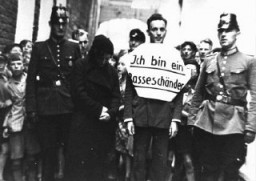
Poster promoting the Nazi monthly publication Neues Volk. Jews were not the only group excluded from the vision of the "national community." The Nazi regime also singled out people with intellectual and physical disabilities. In this poster, the caption reads: "This hereditarily ill person will cost our national community 60,000 Reichmarks over the course of his lifetime. Citizen, this is your money." This publication, put out by the Nazi Party's Race Office, emphasized the burden placed on society by…
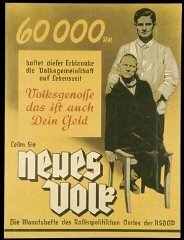
A Hitler Youth poses for a photograph in the Rhineland city of Bruehl, 1934. The Hitler Youth and the League of German Girls were the primary tools that the Nazis used to shape the beliefs, thinking and actions of German youth.
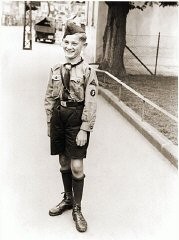
Poster: "Students/Be the Führer's propagandists." With militant appeals to nationalism, freedom, and self-sacrifice, the Nazi Party successfully recruited students disenchanted with German democracy and their current student organizations.

In Berlin, a German woman reads a copy of the Berliner Illustrierte newspaper, featuring photographs of Mussolini's official visit to Berlin in September 1937.
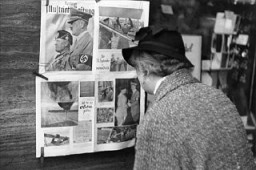
Front page of the most popular issue ever of the Nazi publication, Der Stürmer, with a reprint of a medieval depiction of a purported ritual murder committed by Jews.
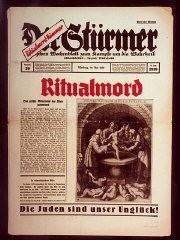
1936 poster: "All of Germany Listens to the Führer with the People's Radio." The poster depicts a crowd surrounding a radio. The radio looms large, symbolizing the mass appeal and broad audience for Nazi broadcasts. Bundesarchiv Koblenz (Plak003-022-025)

An antisemitic poster published in German-occupied Poland in March 1941. The caption reads, "Jews are lice; They cause typhus." This German-published propaganda poster was intended to instill fear of Jews among Christian Poles.
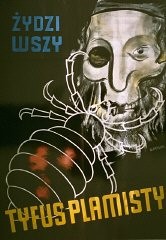
This poster from 1945 shows an embattled German family proclaiming, "Frontline City Frankfurt will be held!" A Frontstadt was a city Hitler declared must be defended against Allied attack at all costs. In the final months of the war, propaganda efforts were directed at rallying the populace for a final defense of the country.
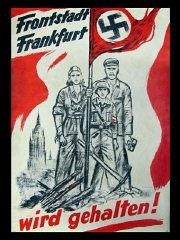
Poster: Nuremberg / Guilty! After the end of the war and the defeat of Nazi Germany, Allied occupation authorities in Germany used posters such as this one to emphasize the criminal nature of the Nazi regime.
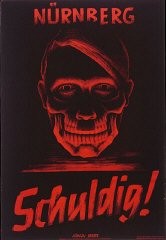
During World War II, the Nazi regime financed and facilitated anti-British and antisemitic broadcasts by the former Mufti of Jerusalem, Hajj Amin al-Husayni, an Arab nationalist and prominent Muslim religious leader, to mobilize support for Germany and the Axis among Muslims in the Balkans and the Middle East. At the close of the war, al-Husayni was arrested in the French occupation zone of Germany. After authorities moved him to France, al-Husayni fled to Egypt, where he continued to produce and…
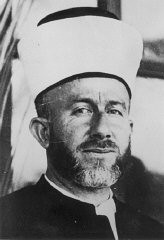
The Jacobsthal family poses with an aunt and uncle who are visiting their home in Amsterdam before emigrating to Chile. Amsterdam, The Netherlands, February 1938.

Cuban immigration papers issued to Ella Schatz, who had obtained passage aboard the Orinoco. On May 27, 1939, the Orinoco left Hamburg with 200 passengers bound for Cuba. Informed by radio of the difficulties other ships carrying refugees were facing in Havana, the captain of the Orinoco diverted the ship to waters just off Cherbourg, France, where it remained for days. The 200 refugees ultimately returned to Germany in June 1939. Their fate remains unknown.
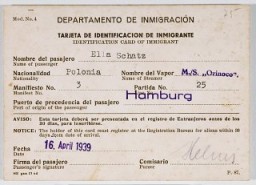
View of a bridge spanning a canal in Nuremberg. The houses and bridge are decorated with Nazi flags and banners. Photograph taken by Julien Bryan in Nuremberg, Germany, 1937.
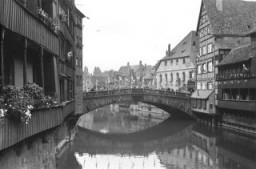
Julien Bryan was an important US documentary filmmaker and photographer who captured the everyday life, work, and culture of individuals and communities in many countries around the globe. Bryan was filming in western Europe in the summer of 1939. In the first week of September 1939, Bryan made his way to Warsaw just as all foreign reporters, diplomats, and Polish government officials were fleeing the capital in the wake of the German invasion. One of the few foreign photographers left in the city, he…
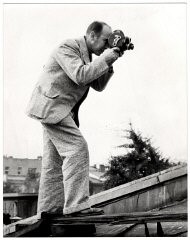
View of the smoldering ruins of a building in Warsaw following a German aerial attack. Warsaw, Poland, September 1939.
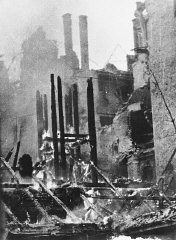
Offices of the International Criminal Tribunal for Rwanda (ICTR) in Arusha, Tanzania.
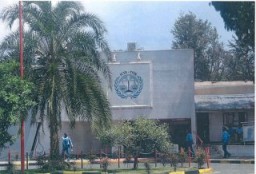
Wanted poster, published by the Rewards for Justice program, seeking key perpetrators who have been indicted by the International Criminal Tribunal for Rwanda (ICTR).
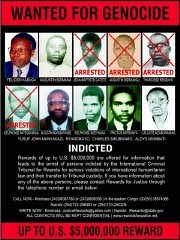
Singer Simon Bikindi sits at the International Criminal Tribunal for Rwanda during his trial for incitement to genocide. Arusha, Tanzania, April 4, 2002.
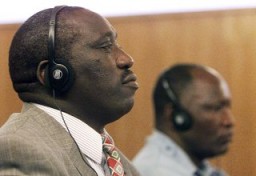
A class of boys from the school in Oradour. All of the people pictured here were killed by the SS during the June 10, 1944, massacre. Oradour-sur-Glane, France, photograph taken between 1940 and June 1944.
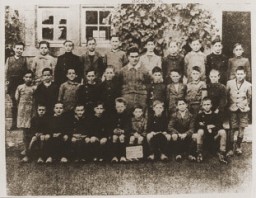
A school class of girls in Oradour. All of the children pictured were killed by the SS during the June 10, 1944, massacre. Oradour-sur-Glane, France, photograph taken 1942–43.
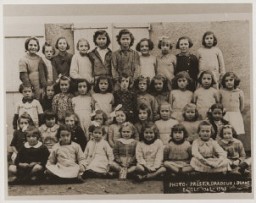
The Machefer family in Oradour. All of the people pictured here, except for the father, were killed by the SS during the June 10, 1944, massacre. Oradour-sur-Glane, France, October 1943.
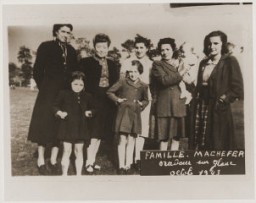
The ruins of Oradour-sur-Glane, destroyed by the SS on June 10, 1944. Oradour-sur-Glane, France, photograph taken in September 1944.

We would like to thank Crown Family Philanthropies, Abe and Ida Cooper Foundation, the Claims Conference, EVZ, and BMF for supporting the ongoing work to create content and resources for the Holocaust Encyclopedia. View the list of donor acknowledgement.